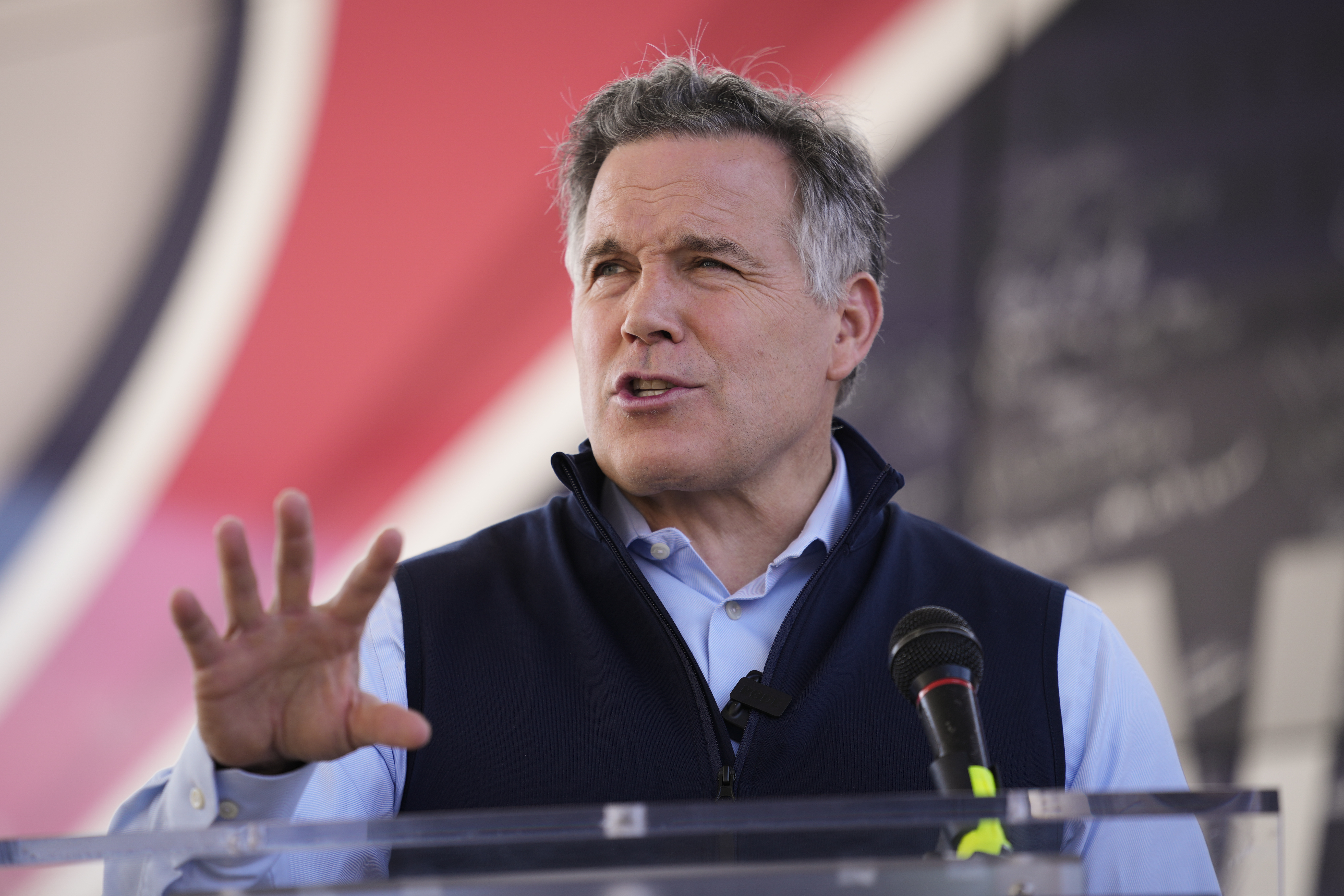Senate Republican spending is heavily concentrated in just a handful of races — a distribution that doesn’t match the reality of the battleground map.
That dynamic is the result of poor fundraising from some key candidates and the party’s reliance on fickle big donors to close the gap. The playing field is ripe with inviting targets, but the advertising from the GOP and its allies is heavily lopsided instead of spread across them. And some of the places where they’re more involved are not the most obvious pickup opportunities.
Instead, a combination of individual candidate strengths and weaknesses, donors’ preferences, and targeting by special interests has created a highly uneven playing field and a clear picture of a party that’s fallen badly behind in individual fundraising.
Among the disparities:
- Republicans and their allies are spending more money in a single state, Pennsylvania, than in Michigan, Wisconsin and Arizona combined.
- In fact, the GOP is spending 2.3 times as much to help former hedge fund CEO Dave McCormick oust a strong Democratic incumbent in Pennsylvania as in Michigan, a similarly purple state that has an open seat.
- More money is going into defending Sen.
Ted Cruz ’s Texas seat, which is considered in play but not highly at risk, than in three Senate races in presidential battlegrounds. - In Arizona, Rep.
Ruben Gallego (D-Ariz.) alone is spending more than all the Republican advertisers, including outside groups, combined. - GOP super PACs and mega-donors are putting more money into former Gov. Larry Hogan’s uphill Senate bid in blue-leaning Maryland than in the Sun Belt targets.
National Republicans would love to seriously contest all of their eight top offensive battlegrounds, and party leaders didn’t set out to create such a heavily uneven map. But races don’t just attract money based on how winnable they are.
“In the case of McCormick and Hogan there are personal reasons why they are attracting the kinds of outside spending that they are,” said Scott Jennings, a longtime adviser to Senate Minority Leader Mitch McConnell. For example: “I know this person, or I love the kinds of politics that Larry Hogan represents.”
Both parties are still pouring money in for the final weeks of the campaign, and a top Senate GOP super PAC has committed millions of dollars in recent days to help close the gap in the Midwest. The price to air ads fluctuates widely state by state, and Pennsylvania is among the most expensive, justifying some of the heavy price tag there.
Still, the shocking disparities could heavily influence Republicans’ success in November — and raise questions about the size of the majority they’re pursuing.
Republicans need to flip only two seats to guarantee control of the Senate, and they already have one, West Virginia, in the bag. Their prime targets, the red states of Montana and Ohio, are fully funded: There’s virtually no air time left for super PACs in Montana. In Ohio, allies of Republican Bernie Moreno are already outspending Democrats by more than $40 million, thanks in part to a $30 million investment by a crypto industry super PAC.
If Republicans can win either of those seats, ousting Sen. Jon Tester in Montana or Sen. Sherrod Brown in Ohio, Senate control is almost certainly theirs. But they entered the cycle eager to flip a slew of other battleground states, including Pennsylvania, Wisconsin, Arizona and Nevada — all places Donald Trump is contesting and energizing the GOP base. They even landed a star recruit who single-handedly put Maryland in play.
But Democratic spending has been overwhelming in some key states.
In Nevada and Arizona especially, the GOP has a more than two-to-one spending deficit, and some party operatives are privately feeling increasingly dismal about their prospects. And the donor dollars flowing into a blue state like Maryland or against a veteran incumbent like Sen. Bob Casey in Pennsylvania underscores the disconnect between donors’ preferences about candidates and other states that may be more primed to flip.
“Donors don’t think like political strategists. They think like donors. And they try to shape where the party is going,” said one Republican operative involved in Senate races, granted anonymity to speak candidly about financial motivations.
Pennsylvania: Republican money pours into helping a former hedge fund CEO oust a tough incumbent
Pennsylvania, a highly competitive swing state, was always going to be a top Senate race.
And McCormick was a prized recruit for the GOP. As the former CEO of one of the world’s largest hedge funds, he has impeccable connections in the finance industry. He’s helped some of the party’s donors grow their wealth during his time on Wall Street, and now they are giving him a major boost.
His allies started a super PAC, Keystone Renewal, funded by a nearly comprehensive list of GOP mega-donors, from the Ricketts to the DeVoses to the Uihleins. As of Oct. 2, it had spent more than $42 million on the Senate race.
Meanwhile, the Senate Leadership Fund, the GOP super PAC closely aligned with McConnell, is spending more than $45 million on ads for McCormick. The outside spending has propelled pro-McCormick advertising in the state to a massive $113 million from Labor Day to Election Day.
Democrats, in comparison, are spending a collective $81.6 million during that period, with $21 million of that coming from Casey’s campaign.
Republicans know McCormick will need every possible minute of advertising to get his message out in Pennsylvania on the crowded and pricey airwaves during a presidential election year.
The son of a former governor, Casey has won six statewide elections in his career. First elected to the Senate in 2006, he won his three races by double-digits or close to it. Even some Republicans acknowledge he is “political royalty” in the state and will be hard to beat.
“Casey’s tough to knock off. I’ve known him for 30 years,” Rep. Dan Meuser (R-Pa.) said. Casey could be dragged down by his association with national Democrats, he said, but McCormick will still need as much money as he can amass: “Outside of that he’s a really nice guy, and that’s how Pennsylvania perceives him. So Dave’s got to really crack it to win.”
Sun Belt: Democrats are drowning Republicans in TV spending, and it’s even worse than it looks at first
Other states that on paper look like better offensive targets than Pennsylvania have received only a sliver of that kind of spending.
Consider Nevada: First-term Sen. Jacky Rosen and her allies are outspending Republican Sam Brown and his supporters by a more than 2:1 ratio from Labor Day on, $45 million to $19 million. Brown has booked only $3 million in ad buys from his campaign compared to Rosen’s $12.5 million.
Hidden behind the overall TV spending numbers is a reality even worse for Republicans in many states.
Candidates can purchase TV ad time at cheaper rates, sometimes significantly discounted, than super PACs or outside groups. But most Republican candidates are raising far less and relying heavily on super PACs to close the gap — meaning much of the pro-GOP spending is far less efficient, seen by fewer voters for every dollar spent.
Democratic Senate candidates have been raising gargantuan sums of money that they’re then able to put into the airwaves. In Ohio, Brown announced last week that he hauled in $30.6 million in the third quarter. Rep. Elissa Slotkin, who is running for Michigan’s open seat, brought in $18 million. Gallego raised more than $21 million in Arizona.
Gallego’s campaign alone has spent or reserved nearly $25 million from Labor Day onward, part of a stunning advertising gap: Democrats have booked $65.7 million, and Republican Kari Lake and her allies have only $23 million.
“It pretty much shows you sort of where the political market believes this race is going,” Kirk Adams, a Republican former Arizona state House speaker, said of the lack of spending by GOP groups. “The real metric to look at is the money they put into Arizona versus the money they put into other contested races. And that probably tells you your story right there.”
Lake, who ran a fire-and-brimstone MAGA-focused race for governor in 2022, has not endeared herself to some key names in the GOP establishment.
“Republicans on the ground here are feeling more optimistic about almost every other race, including legislative races,” Adams said. “That optimism does not include the Senate race.”
Maryland: GOP donors pour money into an uphill battle
Hogan’s Maryland Senate bid is among the most well-supported, with $30 million in GOP TV spending after Labor Day. Democrats are at $17 million.
Hogan’s air domination is powered by the Maryland’s Future super PAC, which is flush with cash from many of the same names that seeded McCormick’s PAC. That group has dropped more than $19 million on ads so far.
That means more GOP dollars are being spent in Maryland, a state that Joe Biden won by more than 30 points in 2020, than in the presidential battlegrounds of Nevada or Arizona.
“You see opportunities there in Maryland that I think are real,” Sen. Thom Tilis (R-N.C.) said. “I think it’s smart. They’re looking at analytics and making decisions that are the right decisions so far.”
Other Republicans are also leaning on bespoke super PACs formed to aid them, though Hogan’s and McCormick’s are more well-funded. Tim Sheehy in Montana and former Rep. Mike Rogers in Michigan also have dedicated outside groups supporting their Senate bids. That allows donors to cut large checks to help a specific candidate, but it also means less control for groups like the Senate Leadership Fund, which is meant to be a party clearinghouse and can direct resources more strategically across the country.
“The decentralization of Republican fundraising is a real thing that is happening, and it will happen even more next cycle,” said one GOP strategist involved in Senate races, granted anonymity to speak candidly. “It incentivizes candidates to build their own ecosystems.”






